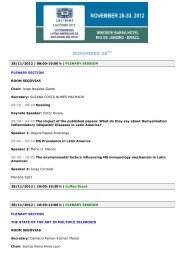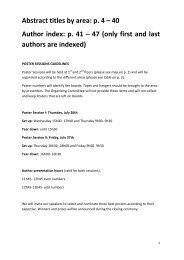Keynote Conference - Interevent
Keynote Conference - Interevent
Keynote Conference - Interevent
Create successful ePaper yourself
Turn your PDF publications into a flip-book with our unique Google optimized e-Paper software.
Symp#18 Perspectives in cancer therapies<br />
Chair Jörg Kobarg<br />
Prospecting and testing new molecular target proteins for cancer therapy: integrating systems and structural<br />
biology”<br />
Jörg Kobarg, PhD<br />
LNBio-Laboratório Nacional de Biociências, CNPEM-Centro Nacional de Pesquisa em Energia e Materiais<br />
Rua Giuseppe Máximo Scolfaro 10.000 Campinas-SP, Brasil, CEP 13083-970 F: 0055-19-3512-1125<br />
Starting from identified cancer related proteins or candidate proteins we explore and integrate several techniques and<br />
approaches ranging from structural biology, micro array, proteomics, protein interactome to cellular and molecular<br />
functional characterization, in order to obtain information on the mechanisms underlying the dysfunction of these<br />
proteins in cancer and to envision new modes of interference aiming at the target specific therapeutic intervention in<br />
cancer. Distinct aspects of this approach are exemplified by three different proteins or groups of proteins currently<br />
under investigation: 1. FEZ1 as a kinesin associated transport adaptor protein that when over-expressed can lead to<br />
the formation of so called “flower-like nuclei“, a hall mark of certain aggressive sub-types of leukemia. 2. Il-7 Receptor<br />
Cys insertion mutations that lead to aberrant receptor homo-dimerization and constitutive activation , growth and<br />
survival of lymphocytes and to tumor formation in the mice model. 3. The 11 human members of the family of NIMA<br />
(Never in mitosis gene A)-related serine/threonine kinases (Neks) have cell cycle-related functions, were recently<br />
described as related to pathologies, particularly cancer, and present promissing chemotherapeutic targets. In order to<br />
understand better the cellular functions of human Nek kinases we performed yeast two-hybrid assays using Nek1, 6, 7<br />
and 9 as baits to identify their protein interaction partners. Similar studies are currently ongoing for Nek 3, 4, 5, 10 and<br />
11. We will present a general overview of our results and their implications for these protein kinases functions in the<br />
context of tumorigenesis.<br />
Modern optical techniques for diagnostic and treatment of cancer and microorganisms<br />
Vanderlei S. Bagnato<br />
Instituto de Física de São Carlos, Universidade de São Paulo, São Carlos, Brazil<br />
Solving health problems with photonics techniques is attractive due to its more selective and fast response, minimally<br />
or non-invasive procedure, and potential low cost instrumentation. These characteristics are especially relevant for<br />
emergent economy countries, where health care is still deficient for large amount of population. Brazil shows a diverse<br />
situation along its large territory: it is possible to find the best medicine with the highest technology available and well<br />
educated personnel, but also a poor health care or even the lack of one. Diagnostics and treatment techniques that are<br />
effective, low cost, and that requires simple instrumentation may be good solutions for improving health care. This<br />
presentation will start with the main principles involved in photonics for live science and present the status of<br />
development for applications in cancer diagnostic and treatmne as well as microbial control.<br />
Deciphering Neuregulin-HER signaling in breast cancer<br />
Atanasio Pandiella<br />
Centro de Investigación del Cancer. CSIC-Universidad de Salamanca, Spain.<br />
The ErbB/HER receptors and their ligands play important roles in animal physiology, and their deregulation has been<br />
linked to diseases such as cancer. Activation of the HER receptors may occur by different mechanisms, including ligand<br />
binding, receptor overexpression, or molecular alterations. In breast cancer, one of the HER family recptors, termed<br />
HER2, is overexpressed in tumors of 20% of patients, and this has led to the development of therapies against HER2<br />
which are now routinely used in the breast cancer clinic. While assessment of the levels of HER receptors in breast<br />
cancer has been extensively analyzed, the role of their ligands has been less well studied. We have explored the<br />
expression of Neuregulins (NRGs), a subgroup of HER ligands, in breast cancer samples. We observed frequent<br />
expression of these ligands, and such expression was linked to metastatic dissemination and poor clinical outcome,<br />
indicating that targeting this ligand system may be therapeutically beneficial. For this reason, we have started a<br />
program to identify how the NRG-HER signaling system controls the proliferation of breast cancer cells. Genomic as<br />
well as proteomic strategies have allowed us to identify novel signaling intermediates of the NRG-HER system. Using<br />
biochemical, genetic, cell biological techniques, as well as xenografted mice, we have elucidated the participation of<br />
these novel signaling intermediates in NRG-stimulated proliferative responses in breast cancer cells. Pharmacological<br />
action on some of these intermediates allowed us to evaluate the potential therapeutic value of their targeting in<br />
breast cancer.<br />
70





